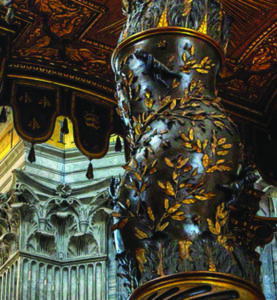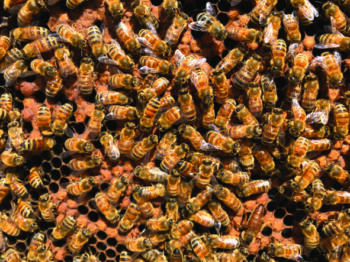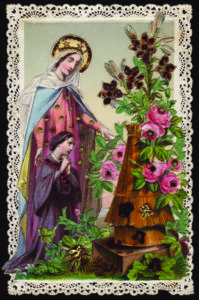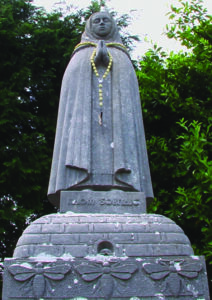Lessons from the Bees
The bee is more honoured than other animals, not because she labours, but because she labours for others.
St John Chrysostom
I’ve been pollinating our household chili plant with a paint brush. I twirl the small brush in the flowers on the chili plant and hope for the best. I have to do this because, as I write, it is winter and there are few pollinators around. So, I’ve been reflecting on what would happen if insects disappeared from the earth.
Seventy to eighty per cent of our food is produced, in part, because of pollinators. And the invertebrate population is in danger of collapsing because of our overuse of insecticides and herbicides; monoculture agriculture, resulting in green “deserts”; and the encroachment of cities and agriculture into insect ecosystems.
Winter is the off-season for beekeepers – and for bees. The days are cold and short. Bees don’t hibernate but cluster in the hives. The closest bees get to hibernation is a sort of torpor. They become “zombees”. Except they aren’t dead and they revive as they warm.
The centre of the cluster, where the queen is, is kept toasty warm by the bees’ disarticulating their wings from their flight muscles and ‘shivering’ them to generate heat. The outer layer of bees is cooler – just above the temperature at which they would die.
When they are in danger of dying, they move deeper into the cluster to warm up and others take their place. This is why bees collect nectar and make and store honey. Honey is the carbohydrate that fuels the shivering muscles, generating heat and enabling the colony to survive the winter.
In a remarkable example of self-sacrifice, sick and worn-out bees leave the colony to avoid dying inside and contaminating the colony.
Bees are certainly fascinating creatures. When spring comes and plants begin to flower in earnest, the scout bees will fly out to locate the best sources of pollen and nectar. They return to the nest with a sample of nectar and on a comb in a particular part of the hive will begin their waggle dance. This comb has become known as the dance floor. Competing dancers will tout their discoveries there.
The dance is a figure 8 pattern that communicates the direction and distance of the nectar source. Direction is communicated by the angle off-vertical, which matches the angle off the sun’s position. The distance is communicated by the distance the dance takes up on the surface of the dance floor. The waggling of their abdomen causes vibrations, which are felt through the wax comb, and picked up by other forager bees who ‘see’ what the dancer is communicating. This all takes place in total darkness inside the hive!
The fascinating part of all this is that the vast majority of bees collect nectar from known sources. However, not all of them do. A significant minority of foragers explore at random, seeking nectar and pollen from sources as yet unknown. Most of these journeys are individually wasteful, but occasionally they pay off hugely in the form of a new find. Without this ‘inefficiency’, hives would starve to death as known sources of nectar are exhausted.

In St Peter’s Basilica, Rome, bees – a symbol of the Barbarini family – decorate the columns of Bernini’s baldacchino
Bees have survived as a species because they use their known waggle dance data up to a point, but allow for the fact that it is temporary, incomplete and weighted to the past. The collective instinct understands old sources dry up, so explorers go out to find new ones and come back to dance the information. Not all foragers are successful and not all dancers are followed, but as a whole the colony renews its ability to sustain itself through this exploration.
Bees reproduce in two ways – the individual reproduction of the newly emerged virgin queen mating with random drones outside the hive and the reproduction of the colony. The newly-mated queen returns to the hive and begins her laying career, spanning several seasons.
However, this is only part of the reproductive process of bees. The colony, the hive, naturally reproduces by swarming. When conditions are right, the old queen leaves the hive for the second time in her life, along with approximately fifty per cent of the population. They swarm and cluster on a nearby branch. From there scouts go out to explore possible hive sites.
In what is almost a democratic process, the scouts return from their discoveries and waggle dance the location and what they consider the suitability of the site. Others go and check and return to dance the same information. Competing dancers publicise different sites and accumulate ‘devotees’. Eventually, the number of devotees of lesser sites falls off. The colony has ‘voted’ and the swarm takes to the air again and flies to the colony’s new home.
As we are challenged by contemporary events and recent history to find new ways of doing ministry and carrying out the Church’s mission according to our charism, we can learn from the bees. Qualities we can admire are the selflessness of individual insects, their collective cooperation in carrying out varying tasks in benefit of the colony, their creative and audacious way of finding and deciding on new sources of sustenance, and the democratic manner in which they decide where to establish new colonies. We can all see the parallels.
So work the honey bees, creatures that by a rule in nature teach the act of order to a peopled kingdom. William Shakespeare




 Entries(RSS)
Entries(RSS)